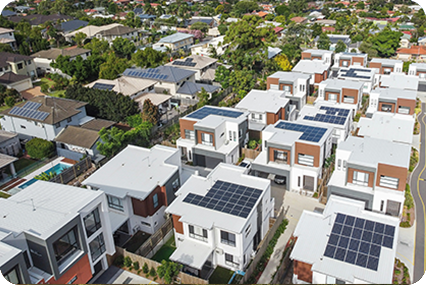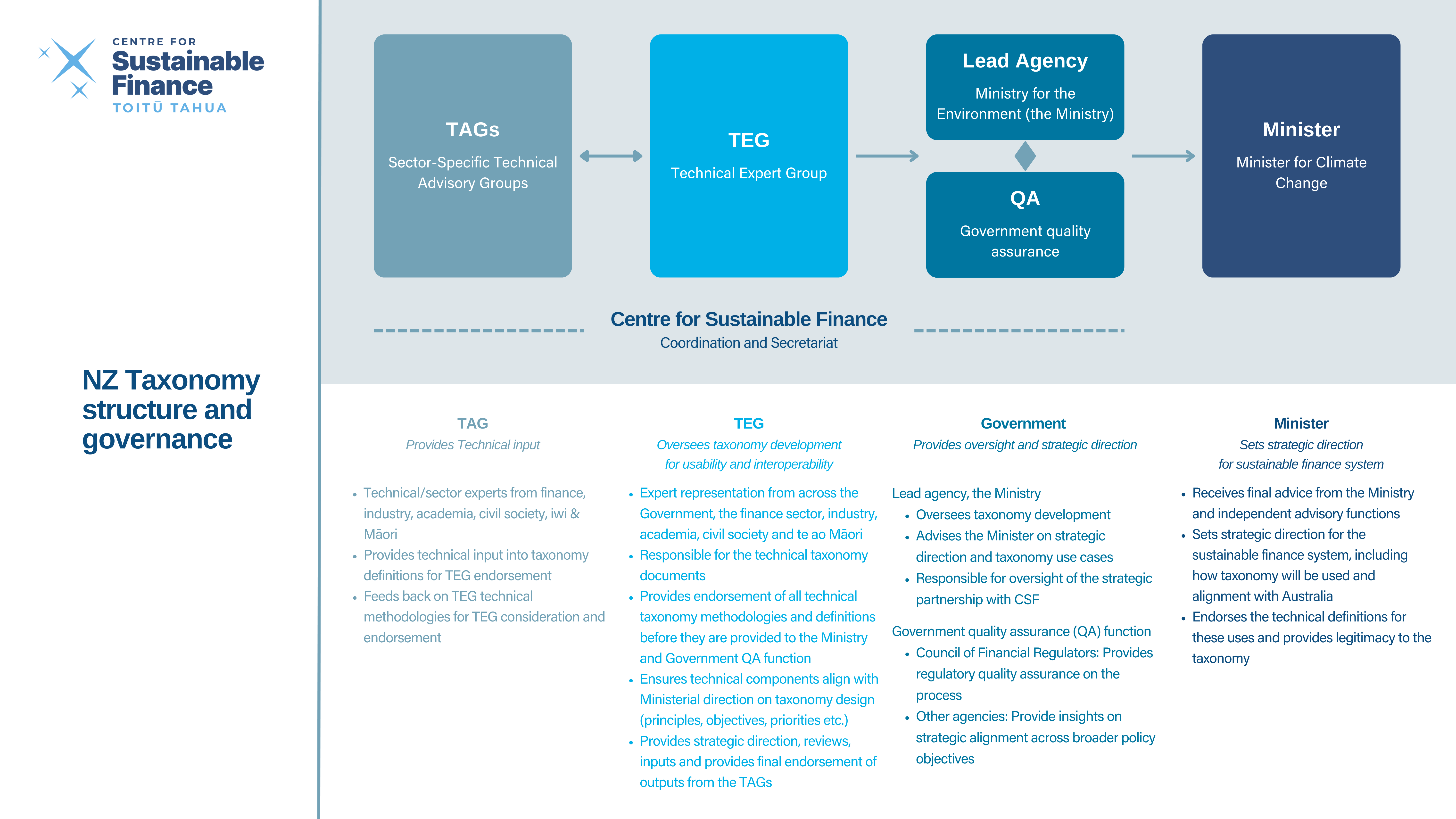A sustainable finance taxonomy is a classification system. It labels and establishes credible criteria for economic activities based on their contributions to meeting environmental goals.
The NZ Taxonomy provides a clear, science-based framework to define which economic activities are aligned to, or enable, substantial progress towards a low-emissions, resilient future for Aotearoa New Zealand.
CSF, in partnership with the New Zealand Government, is working to create a sustainable finance taxonomy for Aotearoa New Zealand (the NZ Taxonomy).
The NZ Taxonomy is being developed through a robust and credible process that was established in alignment with leading international efforts in designing local taxonomies.
There are two types of working group developing the draft NZ Taxonomy:
Expressions of interest for the Construction and Buildings TAG are open now.
This EoI period closes 30 January, 2026. All successful candidates will be notified by 13 February and the first meeting will take place on 19 February, 2026.

Skills and competencies we are seeking:
Other considerations for selection
In selecting TAG members, we will consider not only individual competencies but also the organisational perspective that candidates bring. We will also take into account factors such as:
For details, please review the Construction and Buildings TAG recruitment information pack here.
Purpose of role
Time commitment
Estimated total time commitment: 48 hours (6 business days)
Please read all the materials below before you apply.
Please submit:

The Technical Expert Group (TEG) oversees the development of the NZ Taxonomy. It serves as an intermediary between the Technical Advisory Groups (TAGs), the lead agency, Ministry for the Environment (the Ministry), and the Government quality assurance function. The TEG offers strategic direction, input, and endorsement of all technical taxonomy methodologies and definitions, ensuring usability, interoperability and alignment with Ministerial direction on taxonomy design and that they are fit-for-purpose for NZ.
TEG co-Chairs
TEG members
In 2023-2024, CSF convened an Independent Technical Advisory Group (ITAG) to develop key design recommendations for the NZ Taxonomy. The resulting recommendations report, covering ten key topics, was presented to the Minister for Climate Change and made public in July 2024.
If you have outstanding questions, or would like to discuss the terms or your suitability for TAG membership, please email [email protected] to talk to one of our team.
An Aotearoa New Zealand Sustainable Finance Taxonomy (NZ Taxonomy) provides recognisable definitions that can be used by investors and capital providers who want to make investments into the global transition to a low emissions economy.
Over 50 jurisdictions are developing taxonomies. NZ’s approach is to closely align to the Australian Taxonomy, adapting international definitions to fit our business, legal and policy environment. Being an importer of capital, these definitions need to be recognisable, credible and relevant to investors, while being applicable and suitable in the NZ context.
A common language and approach is preferable to individual organisations creating their own definitions. The standardisation will reduce friction and accelerate the pace and scale of capital flow towards better outcomes.
While taxonomies don’t provide a complete solution, they are vital tools that financial institutions and Government can use to direct capital towards more sustainable outcomes.
Taxonomies offer broader benefits – they help prevent greenwashing, guide Government incentives, attract international green capital, and align with key trading partners’ regulations/standards.
The NZ Taxonomy prioritises interoperability and harmonisation with global standards. It will be closely aligned to the Australian approach, which also follows the principle of ensuring credibility and harmonisation.
CSF is a taxonomy development partner and will coordinate the process, technical delivery and stakeholder engagement for the taxonomy. CSF is not the decision-maker on the various aspects e.g. technical screening criteria, do no significant harm criteria, and minimum social safeguards.
The role of the Government is to provide legitimacy to the process and to provide a predictable source of funding to guarantee a stable environment for the development of the NZ Taxonomy.
Importantly, the Government does not drive the development of the NZ Taxonomy. Instead, it either accepts or declines to endorse the process, rather than evaluating the quality of criteria developed by the TEG and TAGs. CSF is the liaison between all groups and care is taken to ensure that industry and political influences do not hinder the independence of the body developing the technical screening criteria.
Taxonomies prioritise climate change mitigation for several reasons:
Measurability: It’s generally easier to determine and quantify substantial contributions that economic activities make to mitigation efforts.
Established frameworks: There are already well-established best practices, criteria, and thresholds in the area of climate change mitigation, providing a solid foundation for our work.
Adaptation and resilience are crucial for NZ, however there is currently a lack of international consensus on what constitutes a substantial contribution in these areas, largely because these factors are often highly localised. This makes it difficult to establish standardised criteria that are both globally relevant and locally applicable.
Our approach is to focus on mitigation as an immediate priority, with adaptation and resilience developed at the same time, to the full degree possible, while taxonomies develop internationally. This strategy allows us to move quickly while aligning with the Australian adaptation and resilience criteria for agriculture and land use, as global standards evolve.
In line with the recommendations developed by the ITAG, the NZ Taxonomy development and Governance will include Māori experts and perspectives.
Typically, recommendations are made by a technical group comprised of relevant experts to an oversight group, which also considers usability and application in the market and determines whether to accept the technical recommendations. From here, the Government has a role in endorsing (or not) the process taken and ultimately in endorsing the taxonomy.
CSF has recommended that integrity safeguards are put in place to protect the process from undue industry or political influence.
Yes, there are three ways to engage:
Public consultation: Opens from April 2025 to May 2025. Sign up here for reminders.
Join public webinars and/or stakeholder discussion sessions to stay in formed at key phases of the development.
Stay informed: Subscribe below for NZ Taxonomy-related updates.
Sustainable Finance is a broad approach integrating environmental, social, and governance (ESG) considerations into financial decisions.
Green Finance is for activities aimed at supporting environmentally beneficial projects.
Transition Finance helps high-emitting sectors or entities shift towards low-carbon or net-zero pathways.
See this article for more information, including scope, application and examples from New Zealand.
Enter your name and email address to subscribe.
Read more about the Centre for Sustainable Finance.
Grounded in the Sustainable Finance Form’s 2030 Roadmap for Action.
Learn more about our Board and Executive Team.
Our work would not be possible without the support of our partners.
Financing sustainable growth in Aotearoa New Zealand.
A classification system for sustainable economic activities.
Accelerating financing solutions for affordable, abundant clean energy.
Guidance for SMEs to start sustainability reporting.
Promoting greater options for New Zealand investors